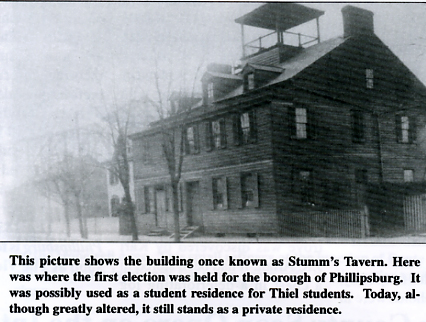
Click Here to Return to Milestones
The first accounting of Monaca PA, is formally
titled, "The 1833 Register of Residents in Phillipsburg."
It was compiled in German script of the day, on July 24, 1833;
the community had been founded just fifteen months earlier. Its
citizens were members of Count Leon's New Philadelphia Society
(NPS). No reason has been given for the register's creation.
The NPS had been chartered at Economy on March 21, 1832, and the
group left for Phillipsburg a few weeks later. The original membership
was comprised of the 176 adults who seceded from the Harmony Society
on March 6; their 70 children; the 40 or so who had come with
Leon from Europe; a very large group who had arrived at Economy
hoping to join the Harmony Society (who were not accepting new
members); and many other Harmonists who were not part of the major
settlement contract with Georg Rapp.
The register shows that by 1833, the population of Phillipsburg
had diminished to 410. Of the adults who had seceded on March
6 of 1832, only 116 remained, along with their 54 children. But
new people had arrived. Some of them had withdrawn from the Harmony
Society; at least 10 more of Leon's followers joined them; nineteen
infants had been born, most in Phillipsburg; and many had been
recruited in a national campaign.

The register shows that in 1833, Phillipsburg was an eclectic
assortment of structures. The premises purchased by the NPS had
included a patch of buildings abandoned by workers of the Phillips
and Graham boat factory. On arrival, the brethren had built a
brick home for their leader and his associates. The rest of the
citizens lived in 37 houses of unspecified construction, 5 log
houses (one is designated, "former summer dwelling"),
a couple of huts, a former boardinghouse, an inn, a brick factory,
and a ferry house. Some residences were away from the others.
No street addresses are provided, but one house is described as,
"on the hill near Vetter," and another was located "near
Becker's 2 miles away."
Living arrangements in Phillipsburg resembled those at Economy.
Residents lived in households, allowing even unmarried individuals
to enjoy family life. The number of people varied from unit to
unit, depending on circumstances and the capacity of the dwelling.
The smallest group was a childless couple; the largest was a family
of ten.
Since most of the people in Phillipsburg were married, the majority
of households consisted of the traditional family: mother, father,
and child(ren). The remainder were composed of people who were
not necessarily related. Usually single women lived with traditional
families: all shared the same set of rooms, took their meals together,
and divided up the household chores. Often these families had
young children, and the placement would have provided the mother
with extra help. In some cases, a spinster helped to balance the
number of men and women in a house.
Single males had different arrangements. Some buildings were designated
as bachelor quarters (Houses #18, #28, and "Hut by Erb"),
and since cooking was done by women, these gentlemen were distributed
among traditional households for meals. A few unmarried men slept
with one household and boarded with another. A number of children
were motherless, and some were completely orphaned. In some instances,
they were adopted, and in other cases, they were placed with married
couples.
It appears that frequently, Phillipsburg households were in transition.
Pages of the register are rife with crossed-out entries of unmarried
members who changed sleeping and/or dining arrangements. One four-member
family had moved from the brick factory, which they shared with
four other households, when a number of departing members vacated
quarters in the ferry house. Soon, four others replaced them.
The "1833 Register of Residents in Phillipsburg" is
truly a rare manuscript. Few know of its existence, and even fewer
have seen it. When Leon fled to Louisiana on September 1, 1833,
he took it, along with most of Phillipsburg's important documents.
For more than a century, the collection remained at the site of
Germantown, the colony established near Shreveport by the Count's
followers.
Early in the 1940s, the trove was discovered by Karl J.R. Arndt.
It had been stored in a chest in a deteriorating log cabin, perhaps
untouched for as long as sixty years. Arndt took the lot, putting
the papers aside for a future project. Unfortunately, he passed
away before he could use the information. The documents were passed
to Yale University, where they remain uncatalogued.
Recently the register was published as the 1833 Residents of Phillipsburg
(now Monaca), Pennsylvania, by the Skeeter Hill Press. The 150-page
book includes all pages of the original document, each placed
side-by-side with its English translation and notes to supply
missing or incorrect information. Several prefaces provide background
information for the reader. An appendix lists all known members
of Count Leon's Philadelphia Society, including people who had
moved from Phillipsburg before the register was compiled.
The 1833 Residents of Phillipsburg is for sale in the gift shop
at The Vicary Mansion.